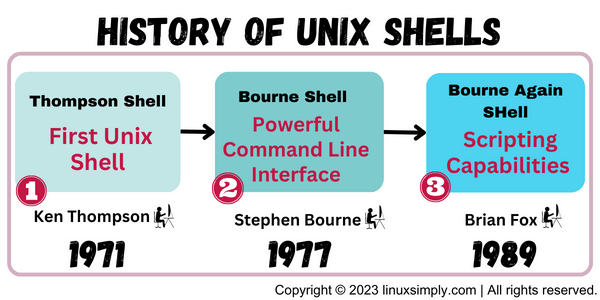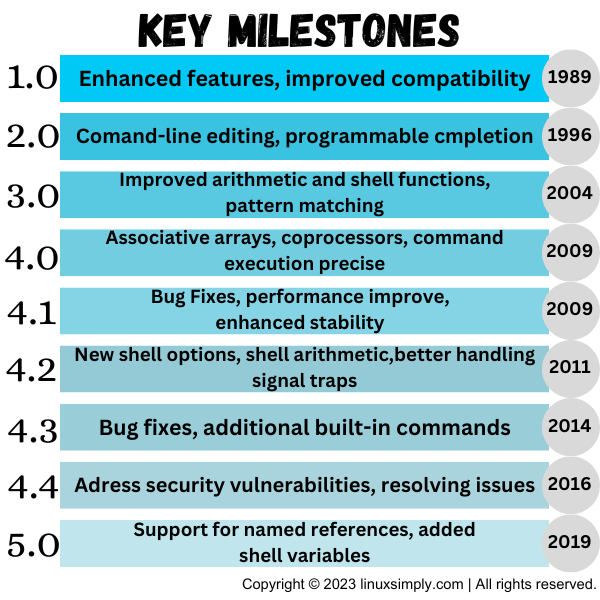Bash, short for “Bourne Again SHell,” is a widely used command-line interpreter and scripting language in the Unix and Linux environments. Developed as a successor to the original Bourne shell (sh), Bash has become the de facto standard for interacting with the operating system and automating tasks through scripts. To understand Bash, first, you should have a firm understanding of Shell and how it works. In this article, you will get an introduction to Bash.
Key Takeaways
- Getting an introduction to the shell.
- Exploring the reason behind the creation of Bash.
- Knowing what roles Bash play as a command line interpreter and a scripting language.
- Getting an idea about the key milestones and versions of Bash.
- Learning the uses of Bash.
What is Shell?
A shell is a user interface that enables users to communicate with an operating system. It serves as a command interpreter, allowing users to enter commands and carry out different computer operations.
A shell takes your commands and tells the computer what to do. Imagine you have a magic notebook, and you want to create a new recipe folder. You say, ” Create a new recipe folder,” and the shell writes it down and magically creates the folder for you. Similarly, on a computer, you have a command prompt or terminal where you can type commands. For example, you can say, “make directory (mkdir),” and the shell will understand and create the folder for you. So, a shell is a way to talk to the computer and give it instructions by typing commands.
Necessity is the Creator of Invention!
In order to address the shortcomings of the original Bourne shell (sh) and provide a more sophisticated and user-friendly shell for Unix-like systems, Bash was created. Back in 1970, many Unix systems used the Bourne shell as their default shell. But it lacked a few features and capabilities, though, which made scripting and user interaction less effective.
Bash as Command Line Interpreter
As a command-line interpreter, Bash provides a text-based interface where users can enter commands to interact with the operating system. It serves as a powerful tool for navigating file systems, executing programs, and managing system configurations. Unlike Graphical User Interfaces (GUIs), which rely on mouse clicks and visual elements, Bash enables users to control their systems using commands written in a specific syntax.
Key Milestones of Bash
I’ve covered some of the Bash versions in this section that are regarded as the Key Milestones of Bash because of their enormous contributions to the language.
- Bash 1.0: The initial release of Bash occurred in 1989 as part of the GNU Project. It provided enhanced features and improved compatibility compared to the original Bourne Shell.
- Bash 2.0: Released in 1996, Bash 2.0 introduced significant improvements, including support for command-line editing, command history, and programmable completion.
- Bash 3.0: Released in 2004, Bash 3.0 introduced features like improved arithmetic support, support for shell functions, and extended pattern-matching capabilities.
- Bash 4.0: Released in 2009, Bash 4.0 brought several enhancements, including associative arrays, improved command-line completion, coprocesses, and more precise control over command execution.
- Bash 4.1: Released in 2009, this version primarily focused on bug fixes and performance improvements, enhancing the stability and efficiency of Bash.
- Bash 4.2: Released in 2011, Bash 4.2 introduced new features such as a new shell options mechanism, improved shell arithmetic, and better handling of signal traps.
- Bash 4.3: Released in 2014, Bash 4.3 included various bug fixes, performance improvements, and additional built-in commands.
- Bash 4.4 beta2: Released in 2016, this version focused on addressing security vulnerabilities and resolving issues discovered in earlier versions.
- Bash 5.0: Released in 2019, Bash 5.0 introduced features like support for named references, added shell variables, and new shell options.

Versions of Bash
I’ve listed the bash versions and their release dates in this section. Hopefully, it will give you a sense of how bash has evolved.
If you want to know which version of Bash you are currently running in your system, I have several ways for you that I have demonstrated below. Steps to Follow > ➊ First, open your Ubuntu terminal. ➋ To get the version of Bash, you have to run any of the commands given below. Or, In the below image, you can see by running both of the commands, I have displayed the Bash version. In addition to being an interactive shell, Bash is also a scripting language, allowing users to create executable scripts to automate repetitive tasks or complex operations. Shell scripts written in Bash can perform various tasks, such as file manipulation, system administration, data processing, and more. The scripting capabilities of Bash make it a valuable tool for both system administrators and casual users looking to streamline their workflows. One of the strengths of Bash lies in its extensive set of built-in commands and utilities, as well as its compatibility with existing Unix commands. It supports features like file and directory manipulation, input/output redirection, pipes, variables, loops, conditional statements, and functions. This rich feature set, combined with its widespread availability across different Unix-based systems, has contributed to Bash’s popularity and continued usage. Bash is highly customizable, allowing users to create aliases, define functions, and modify their environment through configuration files like .bashrc or .bash_profile. This flexibility enables users to tailor the shell to their specific needs and preferences, enhancing productivity and ease of use. Whether you are a system administrator, developer, or curious user exploring the command line, learning Bash can significantly enhance your ability to interact with Unix-based systems efficiently. With its powerful command-line interface and scripting capabilities, Bash empowers users to navigate their systems, automate tasks, and unleash the full potential of the command line. In conclusion, this article has provided a thorough introduction to Bash (Bourne Again SHell), shedding light on its historical significance and emphasizing its key features and usages. By diving into the historical context and understanding the motivations behind Bash’s creation, you gained a deeper appreciation for its evolution and widespread adoption. Throughout the article, I have explored the role of Bash as a scripting language and its power as a command line interpreter. I hope you got a clear initial picture of Bash and will be interested to explore it further. Related Articles << Go Back to Bash Scripting Tutorial
Version
Release Date
bash-2.0
1996-12-31
bash-2.01
1997-06-05
bash-2.02
1998-04-18
bash-2.03
1999-02-19
bash-2.04
2000-03-21
bash-2.05
2001-04-09
bash-2.05a
2001-11-16
bash-2.05b
2002-07-17
bash-3.0
2004-08-03
bash-3.1
2005-12-08
bash-3.2
2006-10-11
bash-4.0-rc1
2009-01-12
bash-4.0
2009-02-20
bash-4.1
2009-12-31
bash-4.2
2011-02-13
bash-4.3
2014-02-26
bash-4.4-beta
2015-10-12
bash-4.4-beta2
2016-07-11
bash-4.4-rc1
2016-02-24
bash-4.4-rc2
2016-08-22
bash-4.4
2016-09-15
bash-5.0-alpha
2018-05-22
bash-5.0-beta
2018-09-17
bash-5.0-beta2
2018-11-28
bash-5.0-rc1
2018-12-20
bash-5.0
2019-01-07
bash-5.1
2020-12-07
bash-5.2
2022-09-26
bash-5.2.15
2022-12-13
How to Find the Running Version of Bash
echo "${BASH_VERSION}"bash --version

Bash as Scripting Language
Why Should You Use Bash?
Conclusion
People Also Ask
FUNDAMENTALS
A Complete Guide for Beginners





